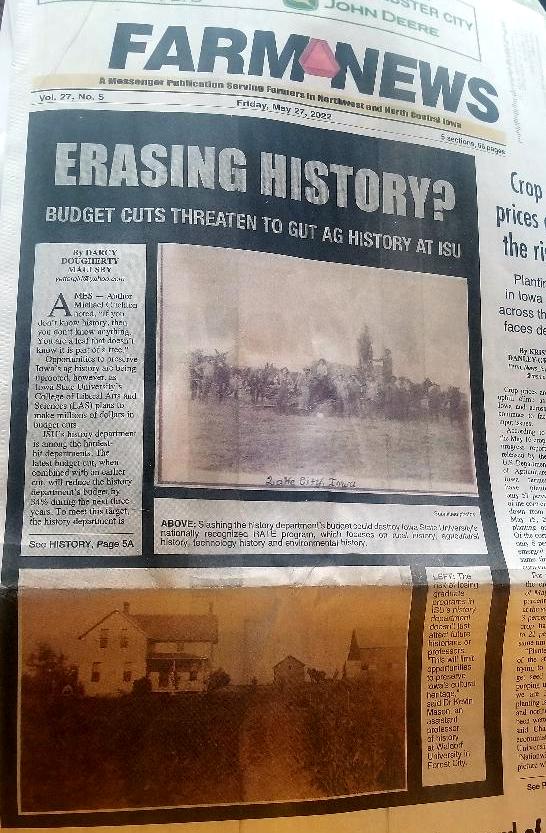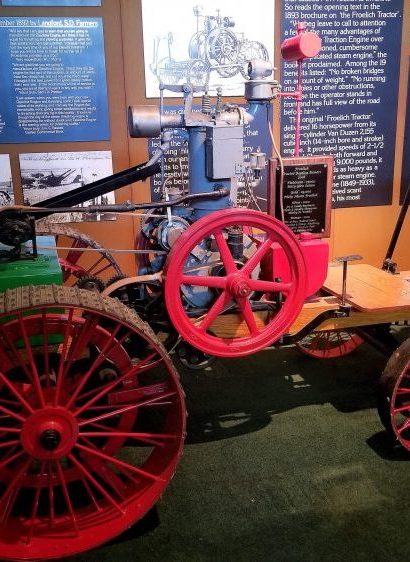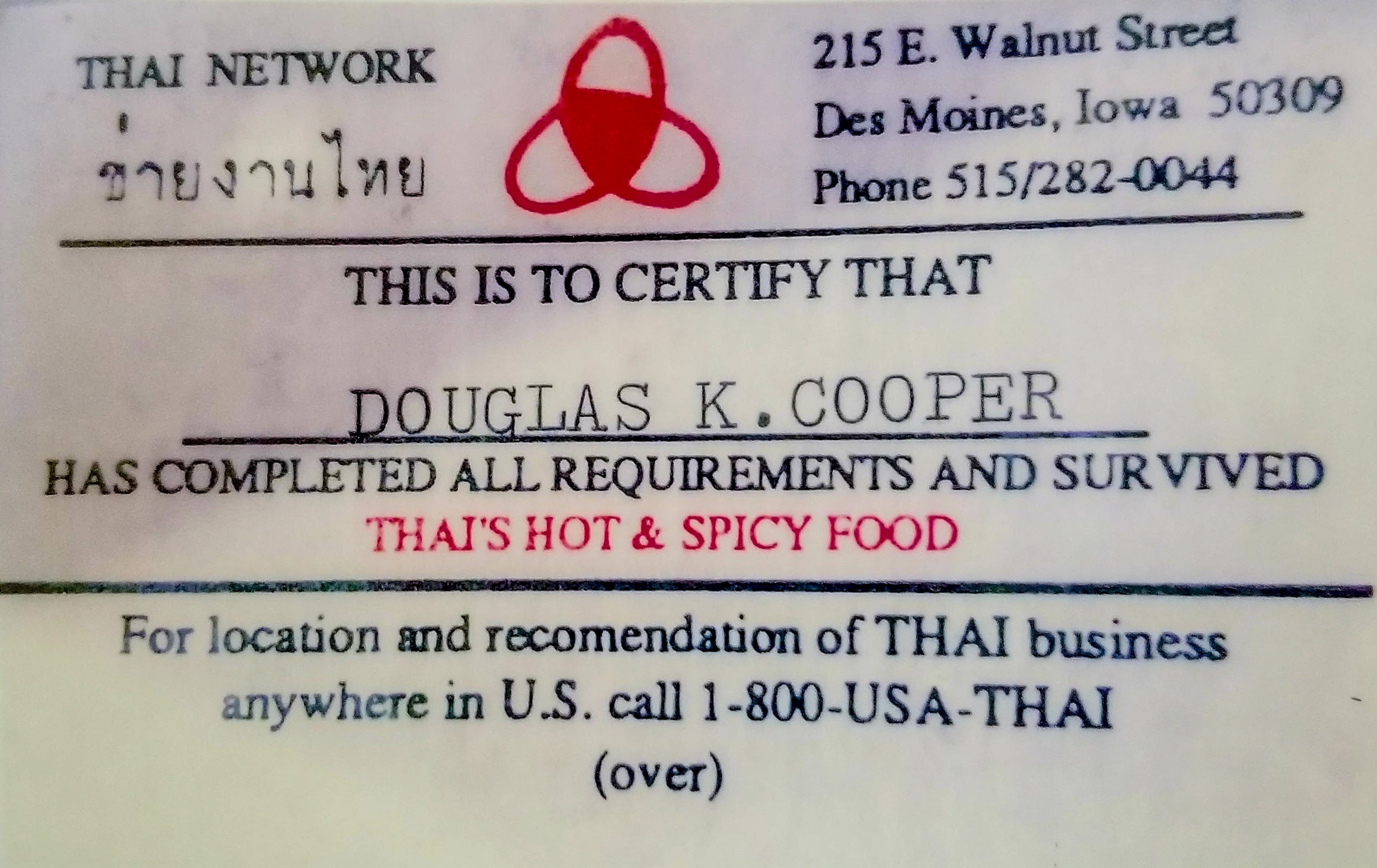
Whats HOT
Latest Posts

4 Key Lessons from Bud Light’s Super Bowl Corn-troversy
What a difference a day makes. Last Saturday, Feb. 2, I was in Altoona, Iowa, teaching my “Harvest Meals Made Easy” class at the Iowa Farm Bureau’s annual Young Farmer Conference. When I shared my three-ingredient recipe for the tastiest, simplest beer bread around, I noted that the type of beer you use isn’t a big deal, although the friend who shared the recipe with me preferred Bud Light.
Since I’m not much of a beer drinker, I didn’t give Bud Light another thought –until I was watching the Super Bowl last Sunday night.
I tuned in for two main reasons—1.) I’m a Tom Brady fan (see my blog post “Can a True Story Well Told Turn You into a Tom Brady Fan?), and 2.) as a marketer, I like to watch the commercials. I was less than impressed with most of the commercials (you paid more than $5 million for a 30-second spot and only came up with THAT???), although I loved the Microsoft ad “We All Win,” With a story revolving around a young boy from Texas, the ad showcased how Microsoft’s Xbox Adaptive Controller helps children with disabilities enjoy gaming. (This inspiring ad, which nearly brought tears to my eyes, topped the list of “most effective” ads with an UnrulyEQ score of 7.5, according to Ad Week.)
One ad that didn’t impress me was Bud Light’s slam against corn syrup. The ad emphasized that Bud Light doesn’t use corn syrup like competitors’ beers do. I thought it was an odd approach to advertise a mass-produced beer. It also ticked me off, since my family grows corn on our Century Farm, but I figured the stupid ad would just fade away into the wasteland of unremarkable, lame marketing.
I was wrong.
Bud Light versus…corn farmers?
Since I always like to hear what others think about these things, I tuned into the radio when I was headed to Ames the morning after the Super Bowl to attend a soil health conference. The general consensus on talk-radio was that the big game was boring (it was the lowest-scoring game in Super Bowl history), and most of the commercials were boring. No one on those shows was talking about the Bud Light commercial—yet.
But then the story exploded.
One of the first volleys in the battle came when my friend Kevin Ross, a farmer from Minden, Iowa, filmed a 9-second video and posted it to Twitter. As he dumped a can of Bud Light down the bathroom sink, he said, “Bud Light, you’re not standing with corn farmers. We’re not standing with you.”
That simple video helped unleash a media firestorm that led to coverage not only in Iowa media outlets, but Fox Business and other national media organizations. The day after the Super Bowl, the New York Times ran the article, “Bud Light Picks Fight with Corn Syrup in Super Bowl Ad.”
In the Feb. 4 story, Wendy Clark, chief executive of the advertising agency DDB Worldwide, noted that the back-and-forth spat may not have been the best result for Bud Light.
“I don’t know if anyone watching the Super Bowl necessarily cares about corn syrup, and it kicked up much ado about nothing,” Ms. Clark said. “It’s taken off into this corn syrup thing and not a Bud Light thing,” she added, “and I don’t know if that was the goal.”
What were they thinking?
I had to agree as I looked at this not as a farmer, but a storyteller who helps business leaders become thought leaders, attract skilled talent, appeal to more prospects and customers, and drive sales, one story at a time.
A cardinal rule of sharing true stories well told? Know your audience.
Back to Bud Light. Does anyone watching the Super Bowl care that much about corn syrup?
I thought about people I know who drink Bud Light. They tend to be hard-working, middle-class, patriotic Americans who just like to relax at the end of the day with an affordable, refreshing cold beer. They are not worried about corn syrup or health concerns related to excess corn syrup, especially when it comes to beer.
Is Bud Light really that clueless about its consumers?
Or are current Bud Light drinkers really the target audience for Bud Light’s advertisements?
Digging into the story behind the data
The question spurred me to investigate what research reveals about the typical Bud Light drinker.
According to InfoScout.com, which gathers consumer insights and demographics, Bud Light consumers are generally lower income, Hispanic and older. It appears that “older” is the key word that applies not just to Bud Light, but Budweiser, too. A Time.com article in 2014 noted that almost half of millennials had never drunk a Budweiser.
“The flagship Budweiser beer remains popular mostly among older folks, and its parent company, Anheuser-Busch InBev, is refocusing its marketing specifically on the millennial age bracket, the Wall Street Journal reports.”
Dazed and confused
Ahhhhh. I began to suspect what’s going on with the Bud Light corn syrup ad is a classic brand struggling to reinvent itself in a beer market that’s changing fast.
The stakes are high. Consider the 2018 Fortune.com article “Americans Are No Longer Drinking Budweiser and Bud Light Beers Like They Once Did,” which noted that sales of domestic lagers have receded as American consumers turn to craft beers, Mexican imports, wine and spirits to get their buzz.
In July 2018, Anheuser-Busch InBev (which manufactures Budweiser and Bud Light) reported that U.S. revenues fell 3.1 percent in the second quarter. The underperformance resulted in the company missing overall sales growth forecasts, triggering shares to drop more than 5 percent.
What’s going on?
Part of the challenge comes from millennials, who make up a sizeable percentage of legal beer consumers in America today. Millennials are the most skeptical generation in history when it comes to advertising. In an advertising-saturated world, this distrust in marketing hype means authenticity is a driving factor for millennials.
Hence the meteoric rise of craft beer, which is infused with authenticity. Compelling stories of local brewers who combine unique ingredients to brew beer in repurposed historical buildings that become hubs of the community capture the imagination—and beer drinkers’ dollars.
While overall U.S. beer volume sales were down 1 percent in 2017, according to the Brewers Association, craft brewer sales bucked the trend.
• Craft beers continued to grow at a rate of 5 percent by volume, reaching 12.7 percent of the U.S. beer market by volume.
• Retail dollar sales of craft increased 8 percent, up to $26 billion.
• Craft beers now account for more than 23% of the $111.4 billion U.S. beer market.
With all these challenges facing traditional brewers, what’s Bud Light to do? A corn syrup-focused ad during the big game clearly wasn’t the answer.
Backlash in the beer war
My friend Kevin, the corn farmer who serves as first vice president of the National Corn Growers Association, told Yahoo Finance the Bud Light ad “implied that [corn syrup] was an inferior product and that the other beers were doing something wrong because they use corn syrup in the brewing process,” and called it an “attack.”
Miller Lite took out a full-page ad in the New York Times on Feb. 6, stating in part, “The ‘corn syrup’ we source from America’s heartland helps make Miller Lite taste so great… It’s unfortunate that our competitor’s Big Game ad created an unnecessary #corntroversy.”
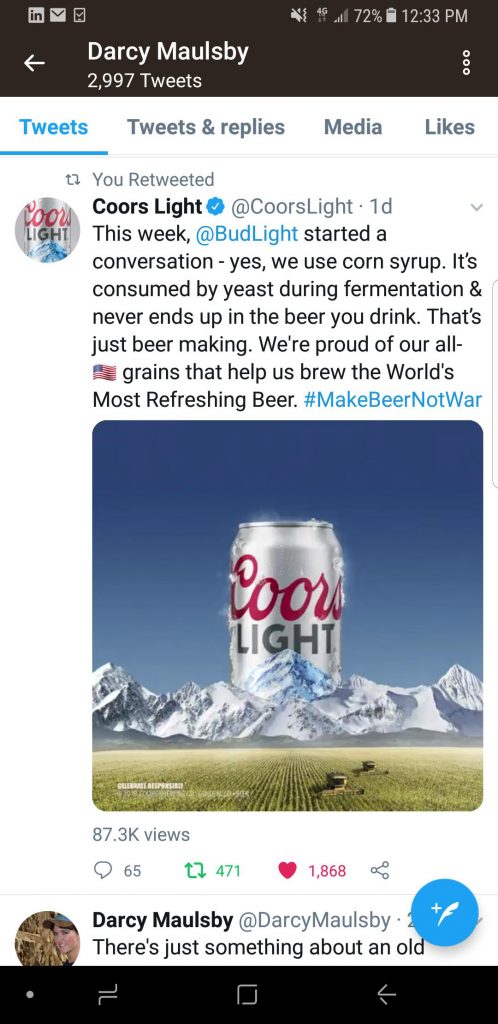 Also on Feb. 6, Coors Light tweeted, “This week, Bud Light started a conversation –yes, we use corn syrup. It’s consumed by yeast during fermentation & never ends up in the beer you drink. That’s just beer making. We’re proud of our all-American grains that help us brew the World’s Most Refreshing Beer. #MakeBeerNotWar”
Also on Feb. 6, Coors Light tweeted, “This week, Bud Light started a conversation –yes, we use corn syrup. It’s consumed by yeast during fermentation & never ends up in the beer you drink. That’s just beer making. We’re proud of our all-American grains that help us brew the World’s Most Refreshing Beer. #MakeBeerNotWar”
It didn’t take long before Bud Light began backtracking. In a tweet on Feb. 6, presented as a note from the king character from the ad, Bud Light said, “Yeesh! That escalated quickly… In the Bud Light Kingdom we love corn too! Corn on the cob, corn bread, popcorn—we just don’t brew with the syrup (what you also call ‘dextrose’).”
I’ll drink to that
So what can we take away from the Bud Light corn-troversy?
1. Know your audience.
2. Authenticity matters.
3. You don’t control your message, especially in a world of social media.
4. Instead of contrived marketing hype, tap into the power of true stories well told.
Want more?
Thanks for stopping by. I invite you to read more of my blog posts if you value intriguing Iowa stories and history, along with Iowa food, agriculture updates, recipes and tips to make you a better communicator.
If you like what you see and want to be notified when I post new stories, be sure to click on the “subscribe to blog updates/newsletter” button at the top of this page, or click here. Feel free to share this with friends and colleagues who might be interested, too.
Also, if you or someone you know could use my writing services (I’m not only Iowa’s storyteller, but a professionally-trained journalist with 20 years of experience), let’s talk. I work with businesses and organizations within Iowa and across the country to unleash the power of great storytelling to define their brand and connect with their audience through clear, compelling blog posts, articles, news releases, feature stories, newsletter articles, social media, video scripts, and photography. Learn more at www.darcymaulsby.com, or e-mail me at yettergirl@yahoo.com.
If you’re hungry for more stories of Iowa history, check out my top-selling “Culinary History of Iowa: Sweet Corn, Pork Tenderloins, Maid-Rites and More” book from The History Press. Also take a look at my latest book, “Dallas County,” and my Calhoun County” book from Arcadia Publishing. Both are filled with vintage photos and compelling stories that showcase he history of small-town and rural Iowa. Order your signed copies today! Iowa postcards are available in my online store, too.
Let’s stay in touch. I’m at darcy@darcymaulsby.com, and yettergirl@yahoo.com.
Talk to you soon!
Darcy
@Copyright 2019 Darcy Maulsby & Co. Blog posts may only be reprinted with permission from Darcy Maulsby.
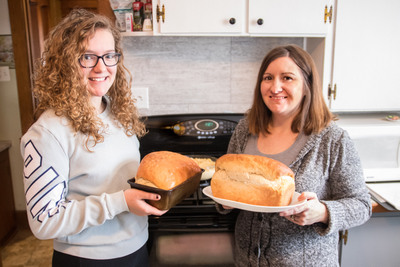
Baking is for Sharing: Best Bread, Grandma Ruby’s Cookies and Other Iowa Favorites
One of the most fun projects I write for clients is the Farm Cook feature that appears in Farm News. I get to meet interesting people in my area and fine-tune my culinary skills, thanks to the wonderful recipes and handy cooking tips they share. Here’s my latest Farm Cook feature with my new friend, Valerie. Enjoy!
What is it about baking that’s so intensely satisfying? Is it the rich aromas, the magic of creating something so comforting, or the opportunity to make family mealtime a priority? It’s all the above for Valerie Stuhrenberg of Pocahontas.
“I’ve always liked to cook and bake,” said Stuhrenberg, a Pocahontas native and registered nurse who works at Stewart Memorial Community Hospital in Lake City. “It runs in the family.”
Stuhrenberg, the youngest of 10 children, credits her father, Keith, with inspiring her love of cooking and baking. While his famous homemade cinnamon rolls were the hit of the neighborhood, Stuhrenberg especially loved his homemade pancakes.
“Dad learned to cook from his Grandma Stanton, who lived in Peterson,” said Stuhrenberg, who noted that he honed his culinary skills in various restaurants, including the Green Lantern Steak House in Decatur, Nebraska, and a restaurant he ran in Rockwell City.
Like many good cooks, Stuhrenberg’s father came from a line of home cooks who didn’t rely much, if at all, on recipes. This tradition of experimenting in the kitchen was passed on to Stuhrenberg, who’s not afraid of a challenge. When a friend who moved to Iowa asked if Stuhrenberg could make her a Kentucky Jam Cake, she wasn’t daunted.
“I said sure, even though I’d never heard of it before,” said Stuhrenberg, who had no trouble making this frosted spice cake.
Stuhrenberg has passed along her love of baking to her daughter, Ally, 14, a freshman at Pocahontas Area High School. When she was a member of the Guys and Gals of Grant 4-H Club, Ally Stuhrenberg’s baked goods, including Kentucky Jam Cake, won top honors at both the Pocahontas County Fair and the Iowa State Fair.
There’s always something homemade and good to eat at home, added Ally Stuhrenberg, who helps cook for her dad, Bob, and younger brother, Trevor, when her mother is working. Home cooking abounds at family get-togethers, added Valerie Stuhrenberg, who noted that all her siblings can cook, and one brother is a chef in the Omaha area. “It makes holidays really fun.”
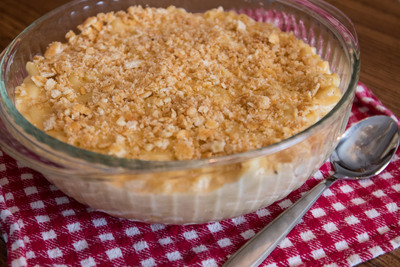
Homemade Baked Mac and Cheese
Baked Macaroni & Cheese
8 ounces elbow macaroni (2 cups dry macaroni)
4 tablespoons butter
4 tablespoons flour
1 / 2 teaspoon salt
Black pepper, to taste
1 / 4 teaspoon nutmeg
1 cup milk
1 cup cream or evaporated milk
2 cups cheddar cheese, shredded
Crumb topping:
Ritz crackers, crushed
Butter
Preheat oven to 400 degrees Fahrenheit. Cook macaroni, and set aside. Melt butter in a sauce pan. Whisk in the flour, salt, black pepper and nutmeg. Add milk and cream (or evaporated milk); boil for 2 minutes, stirring constantly. Turn down the heat, and simmer mixture for 10 minutes, stirring occasionally. Remove from heat.
Add cheese to cream sauce mixture. Combine with cooked elbow macaroni. Pour into baking dish and bake for 10 minutes. As the casserole bakes, combine crushed Ritz crackers and melted butter. (Stuhrenberg doesn’t measure exactly amounts.) After 10 minutes of baking, remove casserole from oven, sprinkle crumb topping mixture over the top, and bake the casserole for 10 more minutes. Remove from oven and serve.
(Note: all the ingredients, other than the crumb topping, can be combined and then frozen so the casserole can be baked later.)
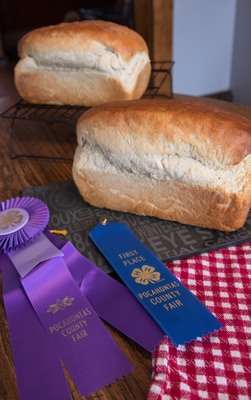
Award-winning Best Bread
Best Bread
4 1 / 2 teaspoons (2 packages) yeast
3 / 4 cup warm water
3 tablespoons soft butter
1 / 4 cup granulated sugar
1 tablespoon salt
2 2 / 3 cups additional water
9 to 10 cups flour
Put yeast and 3 / 4 cup warm water in mixer to proof for 5 minutes. Add butter, sugar, salt and the additional 2 2 / 3 cups water. Slowly add 5 cups of flour. Then add the remaining flour until a dough ball forms. Knead the dough for 5 to 10 minutes in mixer. (You may need to knead the dough in two batches.)
Put dough into a greased bowl, and let dough rise for 1 hour.
Punch down the dough, and separate the dough into two halves for two loaves of bread. Roll the dough out into two 12-inch by 12-inch squares. Then roll each square into the shape of a loaf of bread, tightly tucking in the seams and ends.
Place loaves in greased bread pans, and allow the dough to rise for 1 hour. Bake loaves for 15 minutes in an oven preheated to 425 degrees Fahrenheit. Cover loaves with aluminum foil, and bake 15 minutes more. Remove loaves from oven and cool on wire racks.
Grandma Ruby’s Cookies
This recipe came from Ruby Otto, a farm wife from the Plover area. “She would always make a big batch of these so she could take some to the field at planting and harvest and keep some in the freezer,” Valerie Stuhrenberg said.
2 cups granulated sugar
4 cups brown sugar
4 cups shortening
8 medium eggs
4 teaspoons vanilla
4 teaspoons baking soda
9 to 10 cups flour
2 teaspoons salt
24 ounces chocolate chips
24 ounces raisins
Preheat oven to 350 degrees Fahrenheit. Use an electric mixer to cream together the white sugar, brown sugar and shortening until smooth. Beat in the eggs one at a time, then stir in vanilla. In a separate bowl, combine the baking soda, salt and flour. Combine liquid mixture with dry mixture. Add chocolate chips and raisins to the batter.
Drop by large spoonfuls onto ungreased cookie sheets. Bake for about 10 to 13 minutes in the preheated oven, or until cookie edges are nicely browned. (More baking time creates a crisper cookie, while less baking time creates a chewier cookie.)
Kentucky Jam Cake with Caramel Frosting
Kentucky Jam Cake is a regional specialty. Instead of spreading the seedless blackberry jam between the cake layers, it is incorporated into the cake batter, along with a variety of spices, nuts and dried fruit. The moist, sweet, tangy cake is layered and covered with caramel frosting.
1 cup butter or margarine
2 cups granulated sugar
4 eggs
3 cups flour
1 teaspoon baking soda
1 teaspoon cinnamon
1 teaspoon nutmeg
1 teaspoon ground cloves
1 teaspoon ground allspice
1 cup buttermilk
1 teaspoon vanilla
1 cup of jam (seedless blackberry works well)
1 cup raisins
1 cup pecans, chopped
Cream butter and sugar. Beat in eggs, one at a time. In a separate bowl, sift all dry ingredients. Add the dry ingredients and buttermilk to the creamed mixture. (Alternate the addition of a portion of the dry mixture with a portion of buttermilk until all these ingredients have been incorporated into the batter.)
Add vanilla; mix well. Fold jam into cake batter. Add raisins and pecans; stir to combine.
Bake in two greased, floured baking pans for 35 to 45 minutes. Let cakes cool in pans for 15 minutes before turning the cakes onto waxed paper. Cool or freeze the cake before frosting with Caramel Frosting.
Caramel Frosting
2 1 / 4 cups brown sugar
1 1 / 2 sticks butter
2 tablespoons vanilla
3 tablespoons white corn syrup
4 1 / 2 tablespoons milk
2 1 / 4 cups confectioners’ sugar
Combine brown sugar, butter, vanilla, corn syrup and milk in a saucepan. Heat to melt the mixture. Remove mixture from heat; stir in confectioners’ sugar. Add sugar, as needed, until frosting has a glazed look and reaches the right spreading consistency. Spread frosting on the Kentucky Jam Cake quickly before the frosting hardens.
Black Magic Cake
1 3 / 4 cups all-purpose flour
2 cups granulated sugar
3 / 4 cup cocoa, unsweetened
2 teaspoons baking soda
1 teaspoon baking powder
1 teaspoon salt
2 large eggs
1 cup strong black coffee, cooled
1 cup buttermilk
1 / 2 cup vegetable oil
1 teaspoon vanilla extract
Combine flour, sugar, cocoa, baking soda, baking powder and salt in a large mixing bowl or stand mixer. Add eggs, coffee, buttermilk, vegetable oil and vanilla. Beat at medium speed for two minutes. Batter will be thin.
Pour batter into a greased and floured 9-inch by 13-inch pan, or two 9-inch round cake pans. Bake at 350 degrees for 35-40 minutes for a 9-inch by 13-inch pan, or 30-35 minutes for round pans. Remove cake from oven and cool. Spread with Easy Penuche Icing.
Easy Penuche Icing
1 / 2 cup butter
1 cup brown sugar, packed
1 / 4 cup milk
1 3 / 4 to 2 cups powdered sugar
Boil butter and brown sugar in saucepan for 2 minutes; remove from heat. Stir in milk. Mix in powdered sugar.
Want more?
Thanks for stopping by. I invite you to read more of my blog posts if you value intriguing Iowa stories and history, along with Iowa food, agriculture updates, recipes and tips to make you a better communicator.
If you like what you see and want to be notified when I post new stories, be sure to click on the “subscribe to blog updates/newsletter” button at the top of this page, or click here. Feel free to share this with friends and colleagues who might be interested, too.
Also, if you or someone you know could use my writing services (I’m not only Iowa’s storyteller, but a professionally-trained journalist with 20 years of experience), let’s talk. I work with businesses and organizations within Iowa and across the country to unleash the power of great storytelling to define their brand and connect with their audience through clear, compelling blog posts, articles, news releases, feature stories, newsletter articles, social media, video scripts, and photography. Learn more at www.darcymaulsby.com, or e-mail me at yettergirl@yahoo.com.
If you’re hungry for more stories of Iowa history, check out my top-selling “Culinary History of Iowa: Sweet Corn, Pork Tenderloins, Maid-Rites and More” book from The History Press. Also take a look at my latest book, “Dallas County,” and my Calhoun County” book from Arcadia Publishing. Both are filled with vintage photos and compelling stories that showcase he history of small-town and rural Iowa. Order your signed copies today! Iowa postcards are available in my online store, too.
Let’s stay in touch. I’m at darcy@darcymaulsby.com, and yettergirl@yahoo.com.
Talk to you soon!
Darcy
@Copyright 2019 Darcy Maulsby & Co. Blog posts may only be reprinted with permission from Darcy Maulsby.

Warm Up with Homemade Macaroni and Cheese Soup
It’s 10 degrees outside here in Iowa, the mercury is falling, it’s snowing, the wind is blowing, and I feel invincible—because I have a warm kettle of Mac and Cheese Soup on the stove.
“Soup puts the heart at ease, calms down the violence of hunger, eliminates the tension of the day, and awakens and refines the appetite,” noted Auguste Escoffier, the “chef of kings and king of chefs.”
I couldn’t agree more. Ask me my favorite thing to cook, and the answer is almost always soup. While I love proven recipes, I also like experimenting in the kitchen, like I did today. I made a batch of homemade macaroni and cheese a couple days ago that didn’t turn out quite as creamy as I wanted. I also had a small portion of leftover bacon mac and cheese from a recent meal at the Wild Rose Casino in Jefferson. What to do?
Hmmmm, could I combine these into mac and cheese soup? Is there such a thing as mac and cheese soup?
If not, let’s create it!
After a quick Google search for some culinary inspiration, I came up with a game plan. Since soup-making is more of an art than a science, I always tell people my recipes aren’t rules, just suggestions. You can reduce the milk if you like a thicker soup. Add more salt or pepper if you like. Enjoy a certain vegetable that’s not on the ingredient list? Try adding it. Do what makes sense to you.
A few cooking tips I do encourage:
• Use a pepper grinder to add fresh-ground pepper to your soup. I like to use a mix of red, black, green and white peppercorns for extra flavor.
• Do include the diced peppers. While I used a green pepper, you can user red, orange or yellow peppers, jalapenos, or whatever you have on hand. Peppers enhance the flavor, keep this soup from tilting to the blah side, and help you add extra veggies to your meal. Triple win!
• Go heavy on the onions when making soups. Alice Ann Dial, a neighbor and fantastic farm cook from my hometown of Lake City, Iowa, taught me to not skimp on onions. “They’re cheap and add so much flavor,” said Alice Ann, who learned this cooking trick during her days as a college student at Iowa State in Ames.
• You can make soup a day ahead of time and chill it in the refrigerator until you’re ready to serve. Many soups develop more flavor when they sit overnight, although my Mac and Cheese Soup is packed with flavor right from the start.
The main thing is to keep a spoon handy when you’re making soup, and taste as you go. Remember, you’re creating something special for you and the people you love. Tailor it just the way you like as you create a homemade batch of creamy, hearty, filling soup, perfect for a cold winter night or any time you just want a little extra comfort in your life.
Now please excuse me while I prepare supper and serve Mac and Cheese Soup for my family. Soup’s on!
Hearty Macaroni and Cheese Soup
Mac and Cheese Soup is creamy and oh-so-satisfying, just like mac and cheese. If you’re a mac and cheese fan, this soup is sure to become a favorite.
4 tablespoons butter
2 stalks celery, chopped
2 onions, chopped
2 cloves garlic, minced
2 carrots, grated or diced
1 green pepper, chopped
3 tablespoons all-purpose flour
4 cups chicken broth or vegetable broth
2 to 3 cups milk or half-and-half
1 teaspoon dry mustard
1 teaspoon Worcestershire sauce
1 / 2 teaspoon freshly ground pepper
1 / 4 teaspoon hot pepper sauce
Leftover macaroni and cheese
Bacon, cooked and chopped (optional)
OR
2 cups uncooked small pasta shells
8 ounces Velveeta cheese, cut into cubes
1 cup (4 ounce) shredded cheddar cheese
Melt butter in a Dutch oven or large pot. Add celery, onion, garlic, carrots and green pepper. Sauté until vegetables are soft.
Sprinkle flour on top of vegetable mixture. Whisk together and cook 1 minute.
Gradually whisk in chicken broth and milk. Bring to a simmer. Add dry mustard, Worcestershire sauce, pepper, and hot pepper sauce. Continue to simmer until soup thickens some. Add bacon, if desired.
This next step depends on whether you’re adding leftover macaroni and cheese, or you’re working with uncooked macaroni and the various cheeses. If you have leftover mac and cheese, it to the soup, let simmer for about 20 to 30 minutes, and serve.
If you don’t have leftover mac and cheese, cook pasta shells to al dente in salted water. The pasta will cook a little more in the soup and will absorb liquid, so be careful not to overcook.
Add cubes of Velveeta and stir until melted. Remove soup from heat and stir in cheddar cheese. Stir in cooked pasta, and serve. Enjoy!
Want more?
Thanks for stopping by. I invite you to read more of my blog posts if you value intriguing Iowa stories and history, along with Iowa food, agriculture updates, recipes and tips to make you a better communicator.
If you like what you see and want to be notified when I post new stories, be sure to click on the “subscribe to blog updates/newsletter” button at the top of this page, or click here. Feel free to share this with friends and colleagues who might be interested, too.
Also, if you or someone you know could use my writing services (I’m not only Iowa’s storyteller, but a professionally-trained journalist with 20 years of experience), let’s talk. I work with businesses and organizations within Iowa and across the country to unleash the power of great storytelling to define their brand and connect with their audience through clear, compelling blog posts, articles, news releases, feature stories, newsletter articles, social media, video scripts, and photography. Learn more at www.darcymaulsby.com, or e-mail me at yettergirl@yahoo.com.
If you’re hungry for more stories of Iowa history, check out my top-selling “Culinary History of Iowa: Sweet Corn, Pork Tenderloins, Maid-Rites and More” book from The History Press. Also take a look at my latest book, “Dallas County,” and my Calhoun County” book from Arcadia Publishing. Both are filled with vintage photos and compelling stories that showcase he history of small-town and rural Iowa. Order your signed copies today! Iowa postcards are available in my online store, too.
Let’s stay in touch. I’m at darcy@darcymaulsby.com, and yettergirl@yahoo.com.
Talk to you soon!
Darcy
@Copyright 2019 Darcy Maulsby & Co. Blog posts may only be reprinted with permission from Darcy Maulsby.

Homemade Mac and Cheese Soup
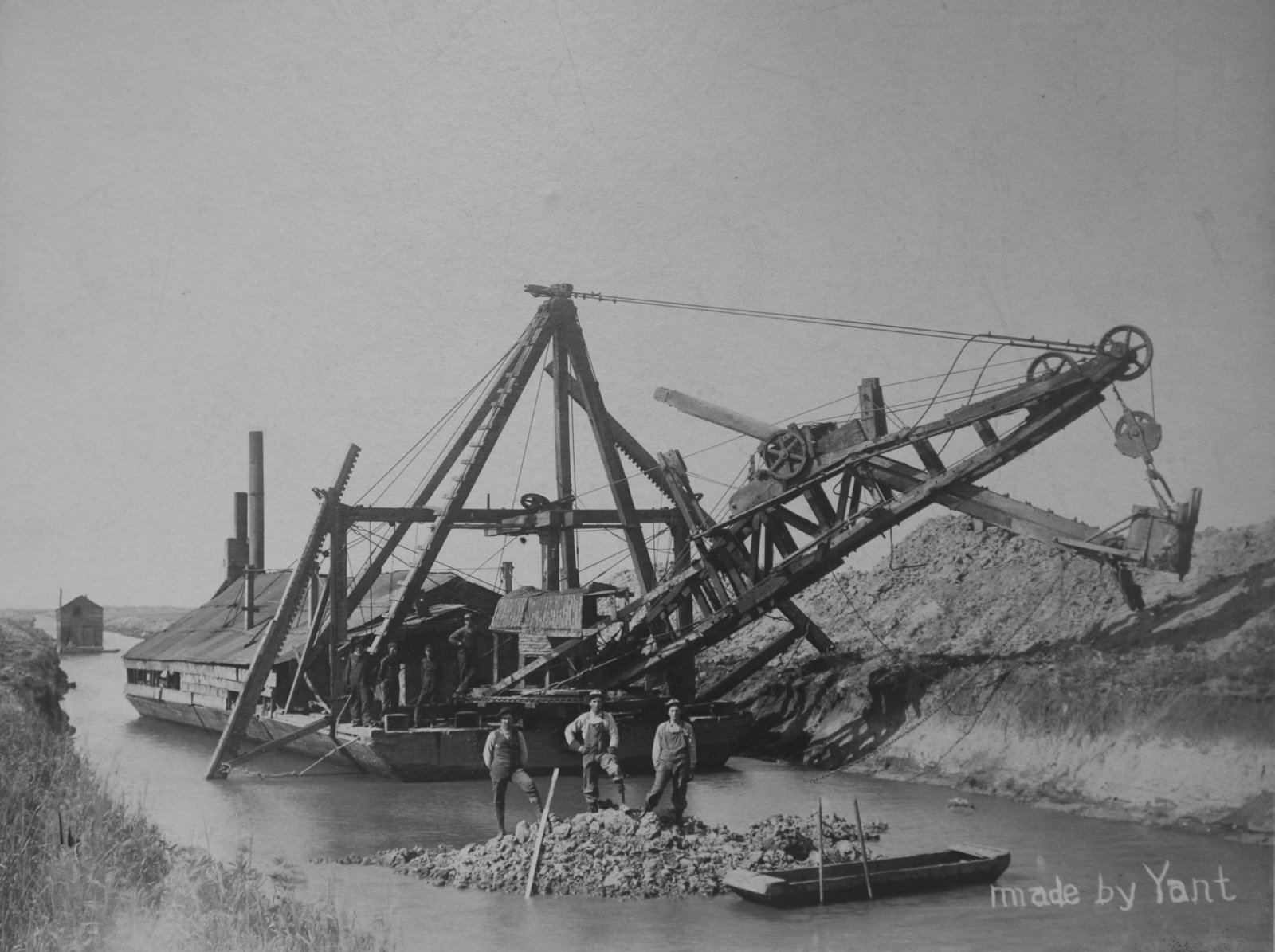
The Untold Story of Iowa’s Ag Drainage Systems
If there were a “Mysteries at the Museum” television series geared towards agriculture, this item would be ideal to lead in a segment. It’s hollow, it’s made of clay, it contains a message from the past, and it was buried in the ground for decades.
It’s a unique clay drainage tile dated 1885, and it’s on display in the Greene County Historical Society’s museum in Jefferson. The message carved around the exterior of the tile reads, “We the men who started the tile work did so with a motive to benefit the town and country. Signed T.P. LaRue of Scranton, Iowa.”
An interpretive sign by the tile shares a quote from S.J. Melson, a former Greene County engineer, to explain the curious item’s history. “This tile was placed into my hands by Carl Paup on February 1968. Mr. Paup stated the tile was unearthed and has lasted for many years on the property owned and operated by Harrison Paup of Kendrick Township, Greene County, Iowa.”
That tile reflects a major part of Iowa’s agricultural history that has been buried, literally, for generations, yet this history continues to influence farming methods, especially in the prairie pothole regions of north-central Iowa and northwest Iowa.
“In general, ag drainage in Iowa got its start around 1880, but this varied a lot, depending on the region,” said Joe Otto, a historian and Ph.D. candidate at the University of Oklahoma who works as a communications specialist with the Iowa Water Center at Iowa State University.
The first documented case of a drain tile being installed in Iowa occurred in 1868 on the grounds of Iowa State in Ames, Otto added. Before that, some of the first drainage ditches were dug in the 1850s along the Mississippi River in Des Moines County, just upstream from Burlington, so farmers could help protect themselves from flooding. One of these farmers, John Williams, was later elected to the state legislature and helped get the state’s first drainage laws passed in the 1870s, Otto said.
Drainage affected Iowa’s settlement patterns
Ag drainage was such a major issue in the 1800s that it impacted Iowa’s settlement. “Iowa wasn’t settled east to west, but from the bottoms up to the top of the state’s many river valleys,” Otto said. “Atop the river valleys were the flat, glaciated prairies of north-central and northwestern Iowa. These were settled and farmed starting in the 1870s and 1880s – several decades after farming started along the Mississippi.”
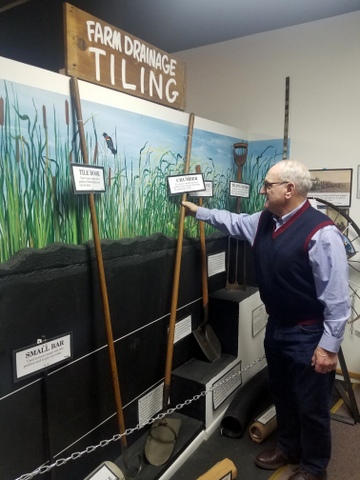
Jim Andrew revisits the exhibit designed by his father, James H. Andrew, a long-time Greene County farmer. This Farm Drainage Tiling exhibit is housed at the Greene County Historical Society’s museum in Jefferson, Iowa.
The region’s extensive swamps and sloughs were remnants of the last glacier, which loosened its icy grip on Iowa approximately 12,000 years ago. “There was a lot of water and nowhere for it to go,” Otto said. “Drainage ditches had to be dug and tile lines had to be laid before the sloughs and swamps of Iowa could be farmed. This started around 1880 and picked up speed in the early 1900s as drainage technology became more advanced.”
Ag leaders like Civil War veteran and pioneer farmer Jesse Allee, who settled in the Newell area in 1871, knew ag drainage would be essential to the development and prosperity of the region. “He was far-seeing with the unshakable belief in the future of the community’s farm land,” stated the 1969 Newell centennial history book on display at the Allee Mansion south of Newell. “Jesse worked hard educating the public to the necessity of proper drainage if this area was to be a leader in agriculture.”
Settlers in Greene County faced a similar situation. “By 1880, many landowners realized underground drainage tile was needed to remove the excess water,” wrote James H. Andrew, a long-time Greene County farmer who created the Farm Drainage Tiling exhibit at the Greene County Historical Society’s museum
in Jefferson before he passed away in 2014.
As more settlers moved into Iowa and demand for tile drainage grew, tile kilns and factories popped up across the state, Otto noted. Greene County, like many Iowa counties, had multiple firms manufacturing clay tile. These businesses used locally-sourced clay, including the Jefferson Cement Products Co., which was located just north of the Greene County Fairgrounds and operated until about 1930, and Lawton and Mass, which produced concrete tile at Cooper for a number of years, starting in 1895.
“There were also small machines made for farmers to mix concrete and scoop it into a manually-cranked device that used metal forms to make various sizes of tile,” wrote Andrew, who was known as “Mr. History.” “They advertised you could make your tile at home for half the cost of commercial tile. But it’s doubtful if this was very successful, since the proper steaming and curing of concrete tiles is important.”
Drainage districts take shape
Ag drainage in Iowa took a major leap forward in 1904, when state legislation provided for the formation of drainage districts. “Farmers could always drain their own lands if they wanted to, but to truly manage drained water meant cooperation with your neighbors,” Otto said.
A group of farmers could petition for a drainage district. An engineer would survey the land to establish the boundaries of the area, and a feasible drainage plan would be developed.
If approved, a contract would be drawn up, with the cost paid by assessing each landowner for his or her fair share, considering his needs and the acres involved. The county acted as the administrator of the drainage district and assessed taxes against the land, as needed, to pay for the initial cost and later for the maintenance of the drainage district. Many times, the money would be borrowed by issuing bonds, and the landowners would make payments on a 10-year plan, Andrew noted.
“The drainage district plan provided the larger tile needed for the main arteries of the system,” Andrew wrote. “Individual landowners were responsible for installing and paying for the lateral tile lines installed on their respective farms to complete the drainage plan.”
From 1904 to 1919, an average of 10 new drainage districts were created per year in Greene County. “That’s a new district about every five weeks,” Andrew wrote.
The 1910s became the golden age of ag drainage when most of Iowa’s public drainage systems were built, Otto added. “By 1912, Iowa’s farmers had spent more money on drainage then the U.S. government spent to build the Panama Canal.”
A Greene County drainage district created in 1916 to drain 998.7 acres using approximately 3.5 miles of tile ranging in size from 10 inches to 22 inches cost of $9,135, [more than $218,640 in today’s dollars], said Michelle Fields, drainage clerk for Greene County. “A drainage district created and installed in 2013 drained 865.5 acres using around 2.38 miles of tile ranging in size from 15 to 24 inches at a cost $532,500,” she added.
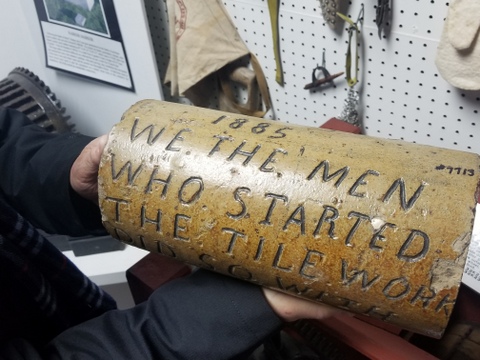
This unique clay ag drainage tile dated 1885 is on display in the Greene County Historical Society’s museum in Jefferson. The message carved around the exterior of the tile reads, “We the men who started the tile work did so with a motive to benefit the town and country. Signed T.P. LaRue of Scranton, Iowa.”
Recalling the life of a ditch digger
By 1920, the formation of ag drainage districts in Iowa slowed down as the post-World War 1 ag depression hit rural America. Still, the work continued.
“Steam power (and later gasoline) engines moved steel and iron machines that could move a lot more dirt around than could horse-drawn scrapers and plows,” Otto said.
Around 1923, after most Greene County drainage districts were in place, the first tiling machines started to be used, although hand digging continued for many years, Andrew noted. In the spring, summer and fall, men could find a job “in the ditch” if they wanted to work. “Many immigrants coming to the USA found their first jobs digging canals, and later drainage ditches. You didn’t have to know English to be a good man in the ditch,” added Andrew, who noted that many of these workers were from Sweden and Ireland.
The early tilers typically lived in tents or small, portable shacks next to the wet land they were draining. They often cooked their own meals and lived off the land by catching frogs for fried frogs’ legs and snapping turtles for turtle soup. They shot ducks, geese and rabbits for meat. Sometimes bullheads and other fish could be caught in the larger ponds, Andrew noted. For water, including drinking water, the men would take a post auger and dig a hole 3 to 4 feet deep and would set in an old farm pump.
“Ditch digging was well organized, and the men were paid by the rods of ditch dug by each man,” Andrew wrote. “No work—no pay. And of course, workmen’s compensation, health insurance and so on were unheard of.”
“Generous gifts”
By the 1970s, corrugated plastic pipe was introduced, which gradually phased out clay tile as the most efficient way to drain land. Today, Greene County has nearly 3,000 miles of drainage district tile and pipes, ranging from 4 inches to 48 inches in diameter. This distance would roughly equal a tile ditch spanning from New York to San Francisco.
“Note that the 3,000 miles is just a measure of the district tiles,” Fields said. “That number would be exponentially larger if you included private tile lines.”
As ag drainage issues have increasingly become intertwined with debates about conservation and water quality, it’s important to keep the line of communication open, Otto said.
“I think the harsh reaction against ag drainage that’s happened in the past few years is due in part to people suddenly wanting to engage in drainage matters, but unsure of what drainage is and does, who administers it and what powers they have. On the other side of the coin, the people trusted to manage the public’s interests in drainage have a responsibility to break down barriers, explain misconceptions and guide the conversation to a common ground.”
That’s a big reason why Andrew documented the history of ag tiling, counting it as one of the most important events in local history and the settlement of the region, noted his son, Jim Andrew of Jefferson.
“Think of the men and the effort it took to dig the clay, form and cure the tile, haul the tile to the jobsite, the survey crews working in ponds and swamps, the drainage plans made by the drainage engineer proving drainage was practical, the legal problems of objections and disputes, letting the bids, and, most important, the hundreds of men with strong backs who worked digging the ditches, laying the tile and filling the ditches,” wrote James H. Andrew.
“Yet, the tile is hidden underground, and the ‘Iron Men’ tilers are all deceased,” he concluded. “As time passes, there is little appreciation for the cooperative efforts that drained Greene County and made it so productive. Only when these old tile systems fail and have to be replaced at great expense will many people realize the generous gifts we’ve received from the drainage district system.”
Want more?
Thanks for stopping by. I invite you to read more of my blog posts if you value intriguing Iowa stories and history, along with Iowa food, agriculture updates, recipes and tips to make you a better communicator.
If you like what you see and want to be notified when I post new stories, be sure to click on the “subscribe to blog updates/newsletter” button at the top of this page, or click here. Feel free to share this with friends and colleagues who might be interested, too.
Also, if you or someone you know could use my writing services (I’m not only Iowa’s storyteller, but a professionally-trained journalist with 20 years of experience), let’s talk. I work with businesses and organizations within Iowa and across the country to unleash the power of great storytelling to define their brand and connect with their audience through clear, compelling blog posts, articles, news releases, feature stories, newsletter articles, social media, video scripts, and photography. Learn more at www.darcymaulsby.com, or e-mail me at yettergirl@yahoo.com.
If you’re hungry for more stories of Iowa history, check out my top-selling “Culinary History of Iowa: Sweet Corn, Pork Tenderloins, Maid-Rites and More” book from The History Press. Also take a look at my latest book, “Dallas County,” and my Calhoun County” book from Arcadia Publishing. Both are filled with vintage photos and compelling stories that showcase he history of small-town and rural Iowa. Order your signed copies today! Iowa postcards are available in my online store, too.
Let’s stay in touch. I’m at darcy@darcymaulsby.com, and yettergirl@yahoo.com.
Talk to you soon!
Darcy
@Copyright 2019 Darcy Maulsby & Co. Blog posts may only be reprinted with permission from Darcy Maulsby.
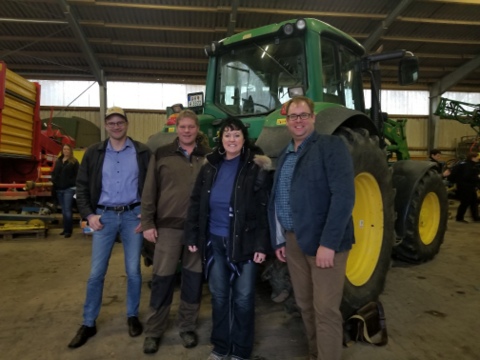
Ag-Vocating Worldwide: Top 10 Tips for Sharing Ag’s Story with Consumers
Any of these sound familiar? Many consumers today don’t understand modern agriculture. Activists are spreading misinformation about farming. Myths about farming seem to carry more weight than facts. I couldn’t believe what I was hearing. While these things are top of mind for me here in Iowa, they’re hot topics in Germany and across Europe, too.
So what do you do about it? We shared best practices when I joined five other ag leaders from Iowa in northern Germany to meet with European farmers, veterinarians and other ag professionals during the Transatlantic Agricultural Dialogue on Consumer Engagement from November 11-16, 2018.
“This experience highlighted why we must make time to share the what and why of how we do things on the farm,” said my friend Chad Ingels, a farmer from Randalia, Iowa, who participated in the Germany study trip, which was supported by the German-American Chamber of Commerce. “Consumers around the world really have no idea what happens in the day-to-day activities on the farm. We need to share our story and keep it simple, without using ‘farmer jargon.’”
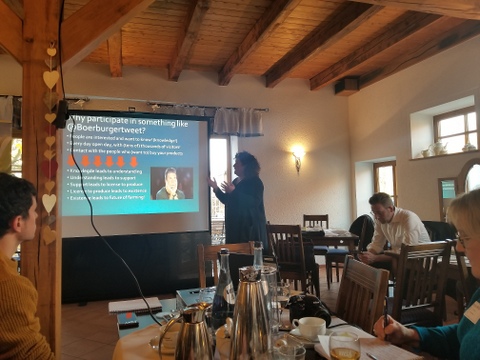
Learning practical tips in Germany for telling ag’s story effectively
Ingels, who raises corn, soybeans and hogs and is active on social media, appreciated the opportunity to exchange practical ideas to address the public’s questions about food production. During these discussions, ag leaders from both sides of the Atlantic shared their 10 top tips for engaging with consumers, including:
1. Be willing to engage. Who is telling agriculture’s story, and what are they saying? Don’t leave it to chance, said Caroline van der Plas from the Netherlands, who encourages farmers to build relationships and share their story with consumers, the media and lawmakers. “If you don’t share your story, others like People for the Ethical Treatment of Animals (PETA) will tell it for you,” said van der Plas, who coordinates the Dutch social media project @boerburgertweet, which allows farmers to share their story with consumers on Twitter.
The ripple effect from one story can be powerful, noted Janice Person, online engagement director for Bayer CropScience. She credits one interview more than 20 years ago with Louisiana farmer Ray Young for motivating her to pursue an agricultural communications career. “I was a city girl from Memphis who was interested in ecology,” said Person, keynote speaker at the Transatlantic Agricultural Dialogue on Consumer Engagement. “When I interviewed Ray Young, he had me so focused on his soils that I can still see them in my mind. He explained conservation tillage and helped me understand how he was getting it to work on his farm. By taking the time to tell his story, Ray helped me become an influencer for agriculture.”
2. Look at ag through consumers’ eyes. Empathy matters. People don’t care how much you know until they know how much you care, Person said. “Many people today are hearing things about food and agriculture that scare them. Sometimes people are angry, sometimes they are confused and sometimes they want to listen.” Most people just want what’s best for their families, added Person, who noted that farmers can bring a valuable, real-world perspective to the conservation.
3. Tell a different side of the story. While most consumers have heard a lot about organic farming, they rarely hear about other types of production. “It’s easy for people to think there’s only one side of the story or one way to farm, unless you share a different perspective,” Person said.
4. Focus on the moveable middle. Activists are loud, but they are still a minority, said Nadine Henke, an ag-vocate from Germany. “There are still a lot of people in the middle, but few really understand modern agriculture. We can reach out to them.”
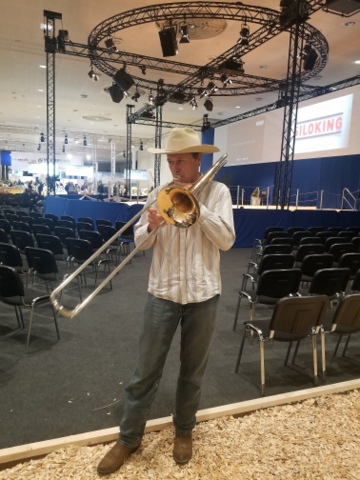
Farmer Derek from Kansas and his trombone, calling the cows
5. Find inspiring ag-vocates. There are many ag-vocates to follow online, from Dirt Sweat N Tears (@farmermegzz on Twitter), a film industry specialist turned farmer from Saskatchewan, Canada, to Derek Klingenberg (@Farmer Derek on Twitter), a Kansas farmer and rancher whose popular YouTube videos range from him playing his trombone to call his cows to a video of a college choir singing in his new grain bin. “We have different crops and livestock and various ways of farming, so our stories are all different,” Person said. “What ag-vocates have in common is their decision to tell their story and make a positive impact.”
6. Never underestimate face-to-face conversations. While social media gets a lot of attention, it’s not the only place to tell ag’s story, Person said. “Some of the most important conservations still take place in person.”
7. Show how technology can be part of the solution. “Most people like to be modern,” Person said. Share the story of modern ag by showing how technology is helping protect the environment with solutions like precision spraying. “People love to discover things,” Person said. “They don’t like to be lectured to. Sharing knowledge can create a sense of wonder.”
8. Stay on track. Challenge people and encourage them to think about a different viewpoint, but always be respectful of your audience, Person said. “Be careful about going on defense too soon. Also, make time to explain not just the how, but why you do what you do on the farm.” Don’t stop with posting pictures, she added. Share your stories of the land and what you think is special about your region. If you have livestock, explain the how and why of manure management. If you like to cook, showcase seasonal foods and recipes. In any case, don’t devote too much time to people who aren’t willing to listen and only want to argue, Caroline van der Plas added. “The longer you engage with activists, the less time you have to tell your story.”
9. Build trust. What’s the ultimate goal of telling ag’s story? Building trust. “It’s all relationship based, and trusted relationships are so important,” Person said.
10. Take the long view. Communication is never a once-and-done deal. It’s an ongoing process. “What can you do in the next year, and the next five years, to tell your ag story?” Person asked. Also, remember that you’re not alone. “Sometimes food and farming issues feel so polarized that it’s easy to forget other people are saying the same things we are,” Person said. “It’s incredibly rewarding to reach out with ag’s story. Know that there is power in coming together.”
So here I am back home in rural Iowa, trying to implement these 10 tips, starting with this article, which originally appeared in Farm News and the Fort Dodge Messenger. I’d love to hear from you, too. In your experience, what works well to share your story effectively?
Want more?
Thanks for stopping by. I invite you to read more of my blog posts if you value intriguing Iowa stories and history, along with Iowa food, agriculture updates, recipes and tips to make you a better communicator.
If you like what you see and want to be notified when I post new stories, be sure to click on the “subscribe to blog updates/newsletter” button at the top of this page, or click here. Feel free to share this with friends and colleagues who might be interested, too.
Also, if you or someone you know could use my writing services (I’m not only Iowa’s storyteller, but a professionally-trained journalist with 20 years of experience), let’s talk. I work with businesses and organizations within Iowa and across the country to unleash the power of great storytelling to define their brand and connect with their audience through clear, compelling blog posts, articles, news releases, feature stories, newsletter articles, social media, video scripts, and photography. Learn more at www.darcymaulsby.com, or e-mail me at yettergirl@yahoo.com.
If you’re hungry for more stories of Iowa history, check out my top-selling “Culinary History of Iowa: Sweet Corn, Pork Tenderloins, Maid-Rites and More” book from The History Press. Also take a look at my latest book, “Dallas County,” and my Calhoun County” book from Arcadia Publishing. Both are filled with vintage photos and compelling stories that showcase he history of small-town and rural Iowa. Order your signed copies today! Iowa postcards are available in my online store, too.
Let’s stay in touch. I’m at darcy@darcymaulsby.com, and yettergirl@yahoo.com.
Talk to you soon!
Darcy
@Copyright 2018 Darcy Maulsby & Co. Blog posts may only be reprinted with permission from Darcy Maulsby.
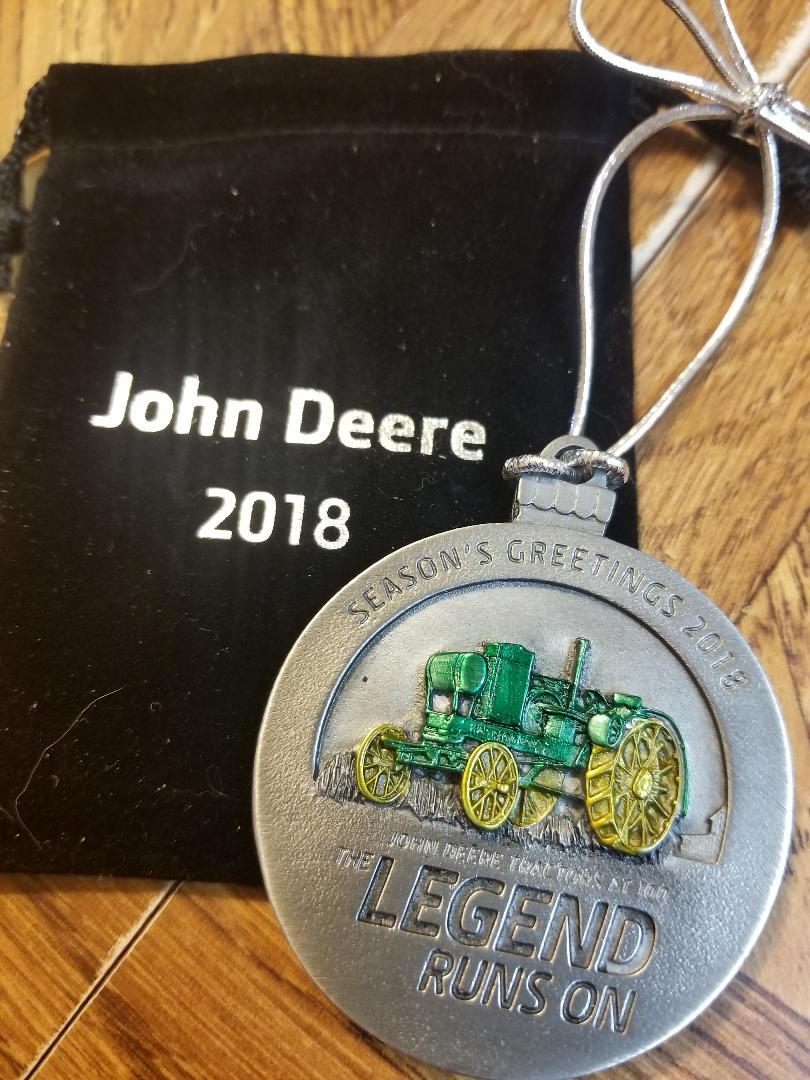
Butter Sculptures to Christmas Ornaments: Waterloo Boy Tractor Celebrates 100 Years
It’s hard to imagine a time when John Deere wasn’t a powerhouse in the tractor business. Yet, John Deere wouldn’t enter the farm tractor business until March 1918 through the acquisition of the Waterloo Gasoline Engine Company, and it’s a milestone that has been commemorated in everything from butter to Christmas ornaments.
Deere has featured a picture and story depicting the 100th anniversary of the iconic Waterloo Boy on its 2018 Christmas ornament. The 2018 Iowa State Fair also honored the tractor by featuring the world-famous Butter Cow beside a butter sculpture of the Waterloo Boy. Both butter masterpieces were displayed in the 114-year old John Deere Agriculture Building’s 40-degree cooler throughout the fair, which ran from August 9-19.
The Iowa State Fair has long been a prime venue to display Deere equipment in its various forms. A quote from the John Deere Sales Department in 1940 read, “I feel that the machinery and industrial exhibits for 1940 excelled any previous year’s display,” according to history shared by the Iowa State Fair. “We consider our Iowa State Fair exhibit to be a very beneficial part of our advertising program, and we will be with you again in 1941.’”
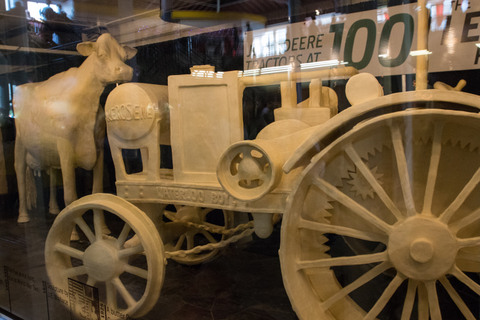
Waterloo Boy butter sculpture 2018 Iowa State Fair
Meeting the challenge of a reliable, durable tractor
Frequently ranked as one of the top events in the country, the Iowa State Fair is the single largest event in the state of Iowa and one of the oldest and largest agricultural expositions in the country and annually attracts more than a million people from all over the world.
In 2018, the Iowa State Fair used more than 50 John Deere tractors and utility vehicles provided by Van Wall Equipment. In addition, a 1919 Waterloo Boy model N tractor was on display in the Machinery Grounds at the Iowa State Fair.
To understand the significance of the Waterloo Boy, take a trip back in time, said Neil Dahlstrom, manager of the John Deere Archives and History. In the critical five-year stretch (1912-1917) prior to John Deere entering the tractor business, there were two key issues the company needed answered.
“First, what did farmers really want from a machine that would soon make the horse obsolete?” said Dahlstrom, who noted that salesmen, territory and branch managers, and Deere’s top leadership scoured the country to understand what customers desired.
Also, how could the equipment to be manufactured to be durable enough to stand up to daily farm use?
Deere had considered every imaginable idea. The company had developed one-, two- and four-cylinder concept tractors. Some ran on gasoline. Others ran on kerosene. Some had all-wheel drive. Others had front-wheel drive. The company even explored concepts like line steering, which was meant to replicate horse reins as the steering mechanism to ease farmers into power farming, Dahlstrom said.
A motorized cultivator, what Deere called a “Tractivator,” was brought to market by several competitors, but Deere determined it did not provide any cost savings compared to horses.
The challenge of producing a durable tractor loomed large. In a letter to company president William Butterworth in 1915, Deere’s superintendent of factories George Mixter noted that tractors offered by competitors up to that point “have not been built with the proper spirit behind the design and manufacture to insure their durability in the hands of the farmers.” But if Deere could “build a small tractor that will really stand up for five or more years’ work on the farm, I believe they will be a permanent requirement of the American farmer,” Mixter wrote.
Deere ultimately found the solution with the Waterloo Boy tractor and acquired the Waterloo Gasoline Engine Company in Waterloo, Iowa, on March 14, 1918. Although anxious to start selling the Waterloo Boy, Deere dealers had to wait while Deere honored existing contracts, which did not expire until Dec. 31, 1918, Dahlstrom said.
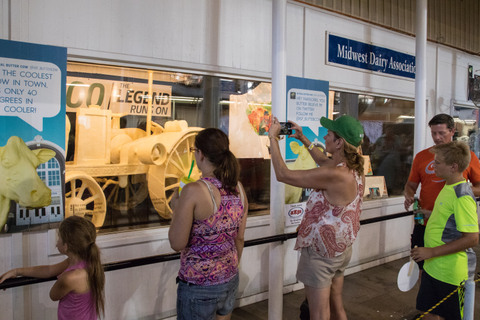
Visitors snapped photos of the iconic Waterloo Boy butter sculpture 2018 Iowa State Fair.
Waterloo Boy makes its debut
Deere put its money where its instincts were. Over the next year, the company spent more than one-third of its advertising budget touting the Waterloo Boy tractor, Dahlstrom said.
Specifically, Deere invested $50,000 on tractor advertising in the year following its debut of the Waterloo Boy—approximately $747,000 in today’s money. Another way to get the company’s new product out in front of customers was to take it on the road – literally.
The National Tractor Demonstrations started to become more mainstream after being introduced in the United States in 1913. An eight-city, eight-week tour schedule was the perfect opportunity to unveil Deere’s Waterloo Boy, Dahlstrom said. Salina, Kansas, served as the ideal backdrop in August 1918, since this was the nation’s largest demonstration.
Deere had participated in tractor demonstrations since the original Winnipeg Agricultural Motor Competitions in Manitoba, Canada, in 1908 – but not with a tractor. Instead, Deere had paired its plows with leading tractor manufacturers. That changed now that the Waterloo Boy was part of the Deere family.
At Salina, Deere spared no expense, showcasing 12 Waterloo Boy tractors as the centerpiece of a display that included John Deere signs, Waterloo Boy signs and a copper leaping deer statue, Dahlstrom said. “There were two stars during this week of 100-degree days – ‘ice water on tap’ and the Waterloo Boy Model ‘N’ tractor,” he added.
The Model “N” demonstrated its merits by pulling tractor plows, disc harrows and grain drills. Visitors were shuttled in three John Deere farm wagons pulled by Waterloo Boy tractors. By all accounts, the debut was a success.
“The award for the most elaborate, largest and most artistic exhibit tent at the Salina tractor show will undoubtedly go to the John Deere Plow company of Kansas City,” wrote the editors of a Kansas City newspaper.
As Deere’s advertising campaign swung into full gear, the Waterloo Boy tractor was promoted as the “best and most efficient tractor” on the market for farmers inclined to buy a tractor. By October 1918, readers of Deere’s magazine, The Furrow, saw an advertisement for the line of Waterloo Boy tractors and stationary engines. The ad guaranteed the Waterloo Boy’s “ample power for field and belt work.”
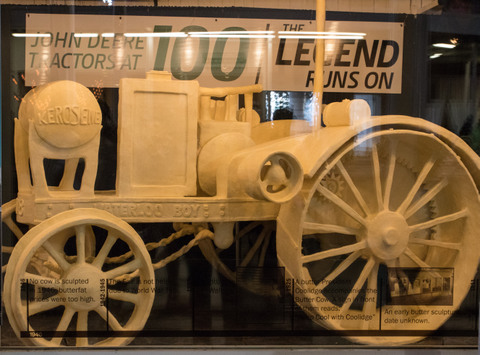
Waterloo Boy butter sculpture 2018 Iowa State Fair
In January 1919, with tractors now available through John Deere dealers, Deere’s first print ad for the trade press appeared in The Farm Implement News. It featured two areas of emphasis: “A Good Tractor Backed by a Permanent Organization.”
After years of development, John Deere customers and John Deere dealers finally had their John Deere tractor.
“It took longer than the company expected, but a determination to do it right instead of doing it fast now brought the John Deere tractor to market,” Dahlstrom said.
As a result, customers got “the assurance of more tractor work per dollar of fuel cost; longer tractor life with less repair cost; accessibility of parts that makes caring for the tractor simple and easy; and dependable power for all farm work.”
The tractor era had officially arrived.
Want more?
Thanks for stopping by. I invite you to read more of my blog posts if you value intriguing Iowa stories and history, along with Iowa food, agriculture updates, recipes and tips to make you a better communicator.
If you like what you see and want to be notified when I post new stories, be sure to click on the “subscribe to blog updates/newsletter” button at the top of this page, or click here. Feel free to share this with friends and colleagues who might be interested, too.
Also, if you or someone you know could use my writing services (I’m not only Iowa’s storyteller, but a professionally-trained journalist with 20 years of experience), let’s talk. I work with businesses and organizations within Iowa and across the country to unleash the power of great storytelling to define their brand and connect with their audience through clear, compelling blog posts, articles, news releases, feature stories, newsletter articles, social media, video scripts, and photography. Learn more at www.darcymaulsby.com, or e-mail me at yettergirl@yahoo.com.
If you’re hungry for more stories of Iowa history, check out my top-selling “Culinary History of Iowa: Sweet Corn, Pork Tenderloins, Maid-Rites and More” book from The History Press. Also take a look at my latest book, “Dallas County,” and my Calhoun County” book from Arcadia Publishing. Both are filled with vintage photos and compelling stories that showcase he history of small-town and rural Iowa. Order your signed copies today! Iowa postcards are available in my online store, too.
Let’s stay in touch. I’m at darcy@darcymaulsby.com, and yettergirl@yahoo.com.
Talk to you soon!
Darcy
@Copyright 2018 Darcy Maulsby & Co. Blog posts may only be reprinted with permission from Darcy Maulsby.
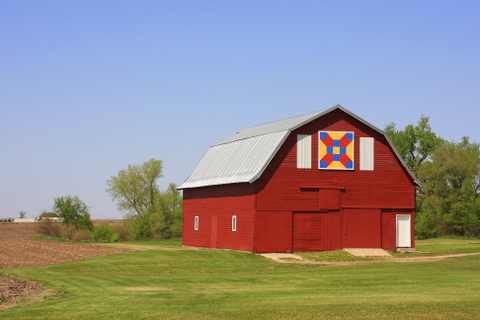
Pieced Together: Barn Quilt Documentary Features Iowa Stories
Barn quilts have become a folk-art phenomenon in Iowa in the past 15 years, turning up not only on barns, but mailboxes, gardens, buildings in town and more. But there was a time not that long ago when no one had ever heard of a barn quilt—not until Donna Sue Groves wanted to add a little color to her corner of the world.
Her story—and those of barn quilt enthusiasts in places like Sac County—inspired the 53-minute documentary “Pieced Together,” which filmmaker Julianne Donofrio showed in Sac City to a full house at the First Christian Church on the evening of Sept. 24, 2018.
“A lot of people don’t know where barn quilts came from,” said Donofrio, who is from the New York City/Washington, D.C. area. “I want people to know Donna Sue’s story.”
The story, which includes many barn quilts across Iowa, began in 1989 when Groves’ family bought a farm in Adams County, Ohio, near the Ohio River Valley at the foothills of the Appalachian Mountains. Groves made a casual remark to her mother, Nina Maxine Groves, about an uninspiring, time-worn tobacco barn on the farm.
“It was the ugliest barn I’d ever seen,” Groves said in “Pieced Together.” “I joked to my mother, ‘I’ll paint you a quilt square on it someday.’”
Game inspires a lifelong love of barns
Groves’ interest in barns dates back to her childhood. When her family would visit Groves’ grandmother in Roane County, West Virginia, Groves’ mother invented a car game to keep Groves and her brother quiet.
“You couldn’t play the typical license plate game when you’re traveling the back roads of West Virginia, because all you saw were West Virginia license plates,” Groves said. “Mother created a car game where we counted barns.”
Some barns were worth two points, while others were worth three points. If a barn had outdoor advertising, like “Chew Mail Pouch” or “RC Cola,” players got a 10-point bonus if they could read the lettering. Red barns also earned higher points. The chance to earn even more points awaited when the family’s wider travels took them past Pennsylvania Dutch barns with colorful, geometric hex signs.
The game led to discussions and questions about the barns, such as who built the barns, and for what purpose. Groves enjoyed these conversational teaching moments. “I looked forward to seeing barns,” she said.
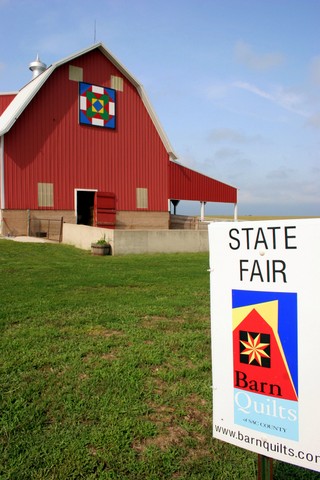
Sac County Iowa barn quilt
Creating a clothesline of quilts across America
This history eventually inspired Groves’ involvement with the first barn quilt square, an Ohio Star pattern, which was created in October 2001 and displayed in Adams County, Ohio. This small gesture triggered a ripple effect across North America.
“If we didn’t pick up on this idea, someone else would,” said Groves’ mother, Maxine, who was featured in “Pieced Together.”
As more people wanted to create barn quilts, Groves and her fellow volunteers quickly learned that painting barn quilts directly onto barns didn’t work too well, but painted plywood squares offered a much better option.
Why stop with just a few barn quilts, though? “A trail of barn quilts could bring tourists here to see all the wonderful things Adams County offers,” noted Groves, who has served as a field representative for the Ohio Arts Council. “Then they’d stay in our bed-and-breakfasts and motels and eat at our restaurants.”
These opportunities for economic development, combined with the visual appeal of barn quilts, soon inspired a “clothesline of quilts” across America. Residents of an adjoining county, Brown County, Ohio, loved Groves’ idea and asked how to get involved. Folks in Tennessee read an article about the Ohio barn quilt project, called Groves and wanted to know how to do a similar project in their area. Grundy County, Iowa, also got involved in 2003, followed by Sac County.
When Sue Peyton and her family from rural Sac City heard about barn quilts, it seemed like a good fit for her son, Kevin, who was in high school and looking for a project he could use as a 4-H leadership project and a Herbert Hoover Uncommon Student Award project.
“I immediately fell in love with the project when I heard about it,” Sue Peyton said. “Barns and barn quilts are such a natural fit.”
The Peytons coordinated the construction and painting of Sac County’s first barn quilts in the summer of 2005. While some people weren’t quite sure what to make of the new barn quilts that started appearing on barns and corncribs around the county, the concept caught on quickly. “We hoped to get 20 barn quilts,” said Sue Peyton, who added that Sac County boasted 55 barn quilts within two years of the start of the project.
“I’ve seen a lot of quilt trails, and you embraced this early on and have done a tremendous job,” said Donofrio as she chatted with audience members in Sac City following her documentary.

Sac County barn quilt proponents Kevin Peyton and his mother, Sue, (center) welcomed filmmaker Julianne Donofrio, who showed her 53-minute documentary “Pieced Together” in Sac City to a full house at the First Christian Church in September 2018.
“We’re here to stay”
Anywhere there’s a barn quilt trail, every square tells a story. Also, there’s no right or wrong way to create a barn quilt. “Barn quilts have a storied history as complex and diverse as the quilt patterns themselves,” Kevin Peyton said.
Consider the Double Aster barn quilt pattern on the Hogue family’s 1943 barn north of Odebolt. The pastel-colored design complements the family’s Prairie Pedlar Gardens business. Owner Jane Hogue, who served on the original Sac County Barn Quilt Committee, enjoyed watching the “Pieced Together” documentary.
“It was fun to see the snippets of Sac County’s barn quilts in the film,” she said. “We’re proud to be part of Sac County’s barn quilt project. With our gardens and tourism, it’s a win-win.”
Sac County proves that barn quilts offer an effective way to help save barns, promote rural tourism and boost economic development, Sue Peyton added. She cited the vintage barn at the Rustic River Winery and Vineyard north of Lake View, for example. It has been remodeled not only into a winery, but a venue where people can host parties and other gatherings.
As the history of the barn quilt phenomenon is preserved through projects like “Pieced Together,” barn quilts are being praised as one of the greatest community art projects ever created. While there are barn quilt trails in 42 states, there is no national barn quilt organization, by design. Creating barn quilts at the local allows local people to make their mark, share their history and establish a legacy. “It’s so adaptable—that’s the beauty of it,” Groves said.
Above all, barn quilts inspire people to view rural communities in a new way. “Barn quilts prompt a question that starts a discussion,” noted a speaker in the “Pieced Together” documentary. “It’s a statement that, ‘We’re here, and we’re here to stay.’”
Barn quilts also prove the power of one person from an isolated rural county to inspire a vision that has touched an entire nation. “As times get harder, we forget how to dream,” said Groves, a cancer survivor. “I like to think the barn quilt trails allow people to dream.”
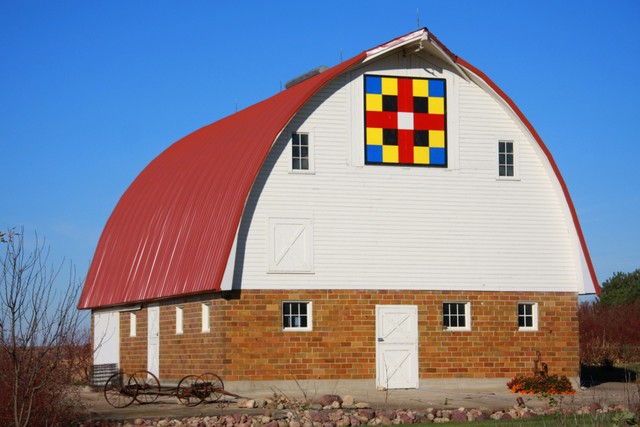
Sac County barn quilt near Early, Iowa
Want more?
Thanks for stopping by. I invite you to read more of my blog posts if you value intriguing Iowa stories and history, along with Iowa food, agriculture updates, recipes and tips to make you a better communicator.
If you like what you see and want to be notified when I post new stories, be sure to click on the “subscribe to blog updates/newsletter” button at the top of this page, or click here. Feel free to share this with friends and colleagues who might be interested, too.
Also, if you or someone you know could use my writing services (I’m not only Iowa’s storyteller, but a professionally-trained journalist with 20 years of experience), let’s talk. I work with businesses and organizations within Iowa and across the country to unleash the power of great storytelling to define their brand and connect with their audience through clear, compelling blog posts, articles, news releases, feature stories, newsletter articles, social media, video scripts, and photography. Learn more at www.darcymaulsby.com, or e-mail me at yettergirl@yahoo.com.
If you’re hungry for more stories of Iowa history, check out my top-selling “Culinary History of Iowa: Sweet Corn, Pork Tenderloins, Maid-Rites and More” book from The History Press. Also take a look at my latest book, “Dallas County,” and my Calhoun County” book from Arcadia Publishing. Both are filled with vintage photos and compelling stories that showcase he history of small-town and rural Iowa. Order your signed copies today! Iowa postcards are available in my online store, too.
Let’s stay in touch. I’m at darcy@darcymaulsby.com, and yettergirl@yahoo.com.
Talk to you soon!
Darcy
@Copyright 2018 Darcy Maulsby & Co. Blog posts may only be reprinted with permission from Darcy Maulsby.
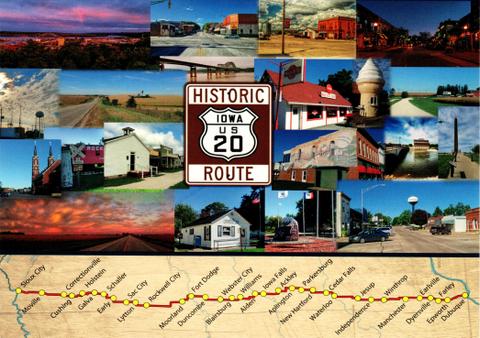
It’s Time to Be 20 Again: Take a Road Trip on Historic Highway 20
It’s a quest that’s decades in the making. When hundreds of people gathered in Holstein on October 19, 2018, for a ribbon-cutting celebrating the completion of U.S. Highway 20 as a four-lane thoroughfare across Iowa, the focus on the future was intertwined with the history of this remarkable road–which offers the perfect route for a road trip.
“Highway 20 is the longest highway in America, spanning 3,365 miles from Boston, Massachusetts, to Newport, Oregon,” said Bryan Farr, founder and president of non-profit Historic US Route 20 Association, which promotes travel along the original 1926 alignment of US Route 20. “Modern travelers aren’t always aware of Highway 20. We want to make it a tourist destination like Route 66.”
Highway 20 passes through 12 states, including Massachusetts, New York, Pennsylvania, Ohio, Indiana, Illinois, Iowa, Nebraska, Wyoming, Montana, Idaho and Oregon. “A lot of interesting things have happened along the highway, from Puritan New England to the Wild West,” said Farr, who shared stories of history, presidents, natural wonders, quirky roadside attractions and more connected to Highway 20 during his program “Historic U.S. Route 20: A Journey Across America’s Longest Highway” on Oct. 14 to a large crowd at the Sioux City Lewis & Clark Interpretive Center.
But first things first—is 20 a highway or a route?
“It depends on where you’re from,” said Farr, who grew up in the Finger Lakes region of New York state and now lives in Chester, Massachusetts. “If you’re from Massachusetts, New York or Pennsylvania, you pronounce it ‘Root’ 20. If you’re from Ohio, Indiana or Illinois you say, ‘Route 20.’ If you’re west of the Mississippi River, it’s Highway 20.”
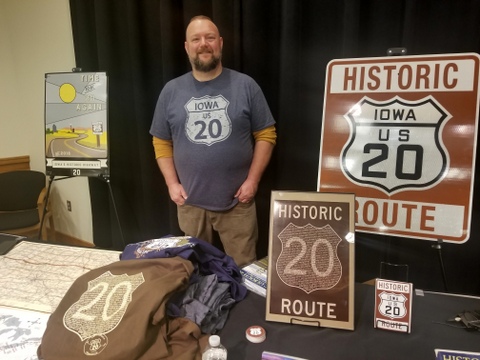
Bryan Farr is the founder and president of non-profit Historic US Route 20 Association, which promotes travel along the original 1926 alignment of US Route 20.
History happened here
The remarkable history of Highway 20 started with the passing of the Federal Highway Act of 1921, which appropriated $75 million for road construction throughout the country. The roads that would become Highway 20 were officially designated during the summer of 1925, with the original alignment of the highway taking shape in 1926.
Creating the modern, efficient, paved, four-lane highway travelers enjoy across Iowa today, however, took decades to create, Farr said. The road was often re-aligned throughout its history, and much of it was gravel for part of the highway’s history. “There are still little sections of the 1926 alignment of Highway 20 outside of Early and Fort Dodge that still are gravel,” Farr noted.
Speaking of Fort Dodge, this Highway 20 city has an unforgettable connection to Cardiff, New York, another Highway 20 town where one of the greatest hoaxes of the nineteenth century took place.
It all started when Stubb Newell of Cardiff, New York, needed a new well. On Oct. 16, 1869, Newell directed two well diggers to a spot he selected behind his barn. The men dug 3 feet and hit something solid. They uncovered a huge stone foot. As they dug more, an entire body of a man emerged. Two days later, a large tent was placed over the 10-foot stone man and crowds of nearly 200 to 500 people a day paid 50 cents to see this giant. Scientists, philosophers and the clergy attended and were challenged in their beliefs, noted the Historic US Route 20 Association website.
Legendary showman P.T. Barnum offered $60,000 for the giant but was turned down. Soon, however, the hoax came to light when people recalled a man named George Hull (a cousin of Newell) had visited a gypsum mine at Fort Dodge in 1868. He commissioned a 5-ton block to be used to carve a statue of Abraham Lincoln. The block of gypsum was shipped to Chicago and carved into this giant man. The carving’s surface was treated with acids and picked at with needles to give it an antiquated look. It was then shipped and buried in New York.
Today, the giant rests at the Farmers’ Museum in Cooperstown, New York. In 1969, a replica was created from the same gypsum quarry and is on display at the Fort Museum in Fort Dodge.
These types of stories offer a unique perspective of Highway 20, which Farr has traveled from coast to coast. “I want to bring people back into small town America, to shop locally and support local businesses to boost economic development in communities that may be bypassed by interstate highways or other more popular routes.”
Gaining a new perspective of Highway 20
Highway 20 is also distinguished by a number of other noteworthy distinctions, including:
• Ties to some of America’s major and mid-sized cities. Highway 20 includes Boston, Buffalo, Cleveland, Chicago and Boise.
• A connection to five presidents. “Highway 20 is a presidential route,” said Farr, citing George Washington as well as Abraham Lincoln, whose famous debates with political rival Stephen Douglas took place in Freeport, Illinois. Highway 20 is also connected Galena, Illinois, where President Ulysses S. Grant had a home. In northern Ohio, Highway 20 passes through Freemont, home of President Rutherford B. Hayes, who served from 1877 to 1881, oversaw the end of Reconstruction and attempted to reconcile the divisions left from the Civil War. Cleveland, Ohio, honors President James Garfield, who was elected president in 1881 but whose service was cut short after 200 days in office when he was assassinated and later died on September 19, 1881.
• The women’s movement organized along the future Highway 20. The Seneca Falls Convention was the first women’s rights convention in the United States. Held in July 1848 in Seneca Falls, New York, the meeting launched the women’s suffrage movement, which more than seven decades later ensured women the right to vote.
• Highway 20 name is more than just name. In 1925, a system of numbered highways debuted in America to replace the jumbled, confusing mess of named auto trails. “Routes with a zero at the end, like Route 20, were transcontinental routes,” said Farr, author of the book “Historic Route 20: A Journey Across America’s Longest Highway.” “Also, east-west routes have even numbers, while north-south routes have odd numbers.”
• Iowa attractions abound along Highway 20. Spanning roughly 330 miles across Iowa from Dubuque to Sioux City, Highway 20 offers plenty to see and do, Farr said. A few options include Dyersville, home of the famous Field of Dreams movie site, the National Farm Toy Museum and the Basilica of St. Francis Xavier; Independence, home of the Heartland Acres Agribition Center, which connects visitors to the past, present and future of Iowa agriculture; Sac County, with its famous barn quilt trail and world’s largest popcorn ball in Sac City and Sioux City, with its rich history related to the journey of the Lewis and Clark expedition nearly 250 years ago.
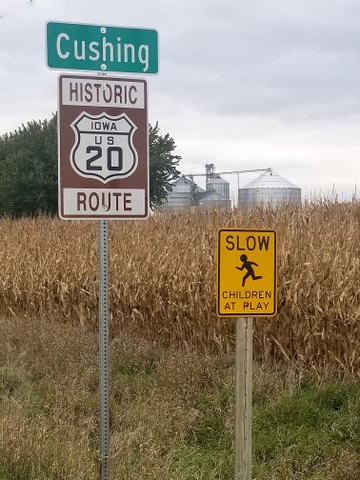
While the first Historic Route 20 sign was placed in Painesville, Ohio, in 2014, Cushing became the first Iowa community to display one of the distinctive signs. This sign greets visitors as they enter the small Woodbury County town from the east on the old route of Highway 20.
It’s interesting to note that bypasses started being built along Highway 20 almost from the start, starting in Massachusetts in the late 1920s. By the 1950s, bypasses in Iowa rerouted Highway 20 out of Farley in eastern Iowa. The trend hasn’t stopped since then. In recent years, communities along historic Highway 20 have been installing signs to denote their unique place along the route. While the first Historic Route 20 sign was placed in Painesville, Ohio, in 2014, Cushing became the first Iowa community to display one of the distinctive signs. This sign greets visitors as they enter the small Woodbury County town from the east on the old route of Highway 20.
While efficient transportation has its place, Farr encourages travelers venture off the interstates and four-lane Highway 20, explore the nearby towns and rural areas and see some the best of America. “Highway 20 is like a companion,” said Farr, who is promoting the new slogan “It’s time to be 20 again.” “This road will take you home.”
Want more?
Thanks for stopping by. I invite you to read more of my blog posts if you value intriguing Iowa stories and history, along with Iowa food, agriculture updates, recipes and tips to make you a better communicator.
If you like what you see and want to be notified when I post new stories, be sure to click on the “subscribe to blog updates/newsletter” button at the top of this page, or click here. Feel free to share this with friends and colleagues who might be interested, too.
Also, if you or someone you know could use my writing services (I’m not only Iowa’s storyteller, but a professionally-trained journalist with 20 years of experience), let’s talk. I work with businesses and organizations within Iowa and across the country to unleash the power of great storytelling to define their brand and connect with their audience through clear, compelling blog posts, articles, news releases, feature stories, newsletter articles, social media, video scripts, and photography. Learn more at www.darcymaulsby.com, or e-mail me at yettergirl@yahoo.com.
If you’re hungry for more stories of Iowa history, check out my top-selling “Culinary History of Iowa: Sweet Corn, Pork Tenderloins, Maid-Rites and More” book from The History Press. Also take a look at my latest book, “Dallas County,” and my Calhoun County” book from Arcadia Publishing. Both are filled with vintage photos and compelling stories that showcase he history of small-town and rural Iowa. Order your signed copies today! Iowa postcards are available in my online store, too.
Let’s stay in touch. I’m at darcy@darcymaulsby.com, and yettergirl@yahoo.com.
Talk to you soon!
Darcy
@Copyright 2018 Darcy Maulsby & Co. Blog posts may only be reprinted with permission from Darcy Maulsby.
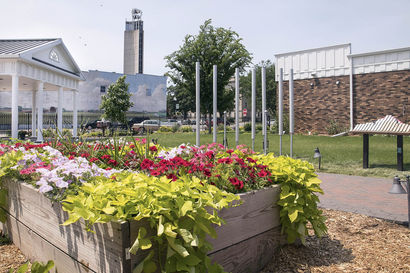
Digging Deeper: Volunteers Showcase Thomas Jefferson Gardens in Iowa
What comes to mind with the name Thomas Jefferson? President, perhaps? Avid agriculturist and gardener also fit, especially in Jefferson, where locals are quick to share this rich history.
“Cultivators of the earth are the most valuable citizens,” Jefferson wrote in 1785 to John Jay, a fellow founder of the United States and first chief justice of the United States. “They are the most vigorous, the most independent, the most virtuous, and they are tied to their country and wedded to its liberty and interests by the most lasting bonds.”
Jefferson frequently extolled the virtues of the agrarian life and championed self-government. His legacy and ideals are honored on in the Thomas Jefferson Gardens of Greene County, Iowa (TJGGCI), in downtown Jefferson, thanks to dedicated volunteers, local civic groups and other community-minded supporters.
A life-sized statue of Jefferson himself greets visitors to the gardens, which surround the local Welcome Center/chamber of commerce office southeast of the Greene County courthouse. “The statue is so lifelike that I think a person is sitting there when I catch a glimpse of it while I’m working,” said Jean Walker, head gardener and secretary of the TJGGCI.
Jefferson’s interest in agriculture blends seamlessly with a rural community like Jefferson that honors its ag heritage and looks for new ways to promote the area, said John Turpin, a retired social studies teacher and coach from Jefferson who serves as treasurer and historian for the TJGGCI. “Jefferson was a student of the flora and fauna in his home state of Virginia. He also thought agriculture was the most important career a person could have.”
Making something out of nothing
So what came first in Jefferson—the statue or the garden? It all started in 2010 when Wallace Teagarden, a Greene County native, lawyer and long-time admirer of Jefferson’s philosophies, wanted to combine his love of agriculture and Greene County in a lasting legacy to the author of the Declaration of Independence.
Teagarden commissioned Jon Hair, an Iowa native and world-renowned sculptor, to create a statue of Jefferson. While displaying the statue on the courthouse lawn was the original idea, it was decided that the statute should become focal point of the new TJGGCI, located just down the street to the east of the iconic Mahanay Bell Tower.
A great deal of work went into creating the nearly $1 million gardens that visitors enjoy today. “This lot where the gardens are had three dilapidated old buildings on it that had to be removed,” said Mary Weaver, who leads 12-member volunteer board of the TJGGCI.
The ground itself wasn’t ideal, either. Old cans and other debris were buried in the corner behind the area where a filling station once stood on the property. “Multiple truckloads of soil were hauled in here,” Walker said.
Before some of the first plants could even be planted, grant writing and fundraising were essential. Project leaders received grants from Vision Iowa and Grow Greene County, along with support from Alliant Energy, West Central Cooperative (which is now Landus Cooperative, the Greene County Board of Supervisors, and countless other groups and individuals.
By 2014, the first plants were added to the new garden. Today, brick paving connects the five distinct gardens in the TJGGCI, including:
• The farmer’s garden on the east. Volunteers have grown broom corn, white corn, pumpkins, squash, Yukon Gold potatoes, flax and more in this garden, which is near a replica of Jefferson’s “mouldboard of least resistance” for a plow. While serving as minister to France, Jefferson had the opportunity to observe European plow designs. Their deficiencies inspired him to design an improved moldboard (the part of the plow that lifts up and turns over the sod cut by the plow share). He wished to make that lifting and turning action as efficient as possible so the plow could be pulled through the soil with the least expenditure of force. He never sought to patent his design and sent numerous models to friends at home and abroad, where his design met with general approval.
• A prairie garden on the north, filled with native plants. “This is what Lewis and Clark would have seen when they explored Iowa following the Louisiana Purchase,” Turpin said.
• A children’s garden, with beds made from old wagon wheels. This fun garden showcases unique plants like the sensitive plant, whose leaves and stems curl up when touched.
• A flower and rose garden on the west. This garden is filled with 1,000 plants, including many perennials ranging from irises to daylilies. This garden also includes Buck roses, which are hardy varieties developed by Dr. Griffith Buck from Iowa State University. In addition, some of the plants in the garden have been donated from local gardens, including two peony plants that are more than 100 years old, Walker said. Those are located near the garden’s striking pavilion, a Federal design reminiscent of architectural styles associated with Jefferson. Even the little free library in the garden near the pavilion reflects Jefferson’s legacy, since it’s designed to look like Monticello, Jefferson’s estate in Virginia.
• Five raised garden beds on the south. Grapevines grow on a cedar trellis just to the south of the raised beds. The raised beds are used to grow various vegetables that are donated to the local food pantry and congregate meal program. “The first year we planted crops like parsnips, turnips and kohlrabi that Jefferson planted in his own gardens,” Walker said. “Those didn’t prove very popular here, though, so we grow peppers, heirloom tomatoes, peas, green beans and more.”
Learning and growing
Since Thomas Jefferson was interested in music as well as agriculture, the TJGGCI project leaders added whimsical, larger-than-life musical instruments, including a contra base chime and xylophone, to bring sound to the garden.
“We were inspired by the outdoor instruments at Okoboji in the Arnolds Park area,” said Jacque Andrew of Jefferson, who handles marketing for the TJGGCI. “Anyone can play these instruments, and they make the garden more interactive.”
So far, there has been one wedding in the garden in 2016. Tour groups from Des Moines to South Dakota have also visited the gardens.
Volunteers continue to work to make the garden even more inviting. They hope to add a third musical instrument and are hosting another year of Tuesday Talks. These free, educational lectures are held in the garden each Tuesday from noon until 1 p.m. through mid[August. Topics range from perennial gardening to birds in the garden. “A garden is always a work in progress,” Walker said.
That’s part of what brings people together and makes this project inspiring, Weaver added. “These gardens make me so proud of the community. We want to help Jefferson and Greene County become a destination, and the gardens are an important part of this.”
People are listening
P.S. I received this wonderful note from Mary Weaver after this article I wrote ran in Farm News in July 2018:
“On a very pleasant note, we are getting visitors because of the articles. We have, that we are aware of, three different sets of visitors from Humboldt. It is the type of visitor story we will tell the City Council when we report to them in September.
The best anecdote was a woman who was part of an assisted living bus tour that was coming to Jefferson from Humboldt, but the destination was the casino. She persuaded the driver her to bring her to TJG rather than the casino and she stayed the entire length of time the others were gambling.
The second was a couple I met yesterday during Tuesday Talks. It was their second visit for a “Tuesday Talk,” they ate at a local restaurant, went shopping at the quilt and antique store.
Certainly is the type of economic/tourism development we have been hoping to create. Thank you Darcy for your splendid articles about the Thomas Jefferson Gardens.”
Want more?
Thanks for stopping by. I invite you to read more of my blog posts if you value intriguing Iowa stories and history, along with Iowa food, agriculture updates, recipes and tips to make you a better communicator.
If you like what you see and want to be notified when I post new stories, be sure to click on the “subscribe to blog updates/newsletter” button at the top of this page, or click here. Feel free to share this with friends and colleagues who might be interested, too.
Also, if you or someone you know could use my writing services (I’m not only Iowa’s storyteller, but a professionally-trained journalist with 20 years of experience), let’s talk. I work with businesses and organizations within Iowa and across the country to unleash the power of great storytelling to define their brand and connect with their audience through clear, compelling blog posts, articles, news releases, feature stories, newsletter articles, social media, video scripts, and photography. Learn more at www.darcymaulsby.com, or e-mail me at yettergirl@yahoo.com.
If you’re hungry for more stories of Iowa history, check out my top-selling “Culinary History of Iowa: Sweet Corn, Pork Tenderloins, Maid-Rites and More” book from The History Press. Also take a look at my latest book, “Dallas County,” and my Calhoun County” book from Arcadia Publishing. Both are filled with vintage photos and compelling stories that showcase he history of small-town and rural Iowa. Order your signed copies today! Iowa postcards are available in my online store, too.
Let’s stay in touch. I’m at darcy@darcymaulsby.com, and yettergirl@yahoo.com.
Talk to you soon!
Darcy
@Copyright 2018 Darcy Maulsby & Co. Blog posts may only be reprinted with permission from Darcy Maulsby.

Sac County Barn Quilt Attracts National Attention
When Alvin (Al) Liske and his wife, Jean, signed up for the Barn Quilts of Sac County project, they had no idea how much attention this would attract to their stately World War II-era barn west of Early, Iowa.
“Our barn has been featured in Eleanor Burns’ book, ‘Quilt Blocks on American Barns,’ and it was also included on the cover of the Department of Transportation’s 2009 map of Iowa,” said Jean.
Burns, a popular television personality who gained famed for her “Quilt in a Day” system, visited the Liske barn last year when she traveled to Iowa to participate in the Sac County Quilt-a-Fair. She was especially intrigued by the Country Lanes barn quilt pattern that graces the barn’s haymow door. She noted that Country Lanes is a very old pattern that was originally published by Mountain Mist, a company that began selling quilt batting in Cincinnati in 1846.
“We chose the Country Lanes block, because we live on a gravel road,” said Jean, who works in the registrar’s office at Buena Vista University in Storm Lake. “Even though we’re off the beaten path, it’s not uncommon to see people drive out here and take photos of the barn.”
Jean’s father, Herman Puetz, built the barn for approximately $4,000 around 1943 or 1944 on the Boyer Valley Township farm that his family had purchased in 1930. The new barn replaced an existing barn that was made from cottonwood lumber. After the concrete foundation for the new barn was poured, lumber was not readily available for the building, due to the war. In the meantime, the family roller skated on the concrete slab. “When construction started again, I can also remember going with my parents to Albert Lea, Minn., to get the rafters for the barn, and I thought that was a really long trip,” said Jean, who noted that the barn includes glazed tile on the bottom and originally had wood shingles on the rounded, gothic roof.
Herman kept horses in the barn, said Jean, who added that farming with horses could be dangerous. “One time when my Uncle George was hauling manure on our farm, something spooked the horses, and they ran toward a barbed wire fence. My uncle jumped off, and he broke his ankle, which got infected.”
Jean’s father, who was one of 12 children, also milked cows on the east side of the barn and kept plenty of hay in the haymow. “I’d play in the barn with my brothers and sister, and we’d make tunnels and caves and houses with the bales. When enough hay had been fed, there would be bare spots in the haymow, and we’d play basketball up there,” said Jean, who noted that the haymow still includes basketball hoops.
After Jean married Al and the couple moved to the farm where Jean grew up, the Liskes raised cattle and hogs in the barn and farmed from the early 1960s until the 1980s. In 2005, the couple decided to remodel the barn, which still had a good foundation. “It was getting to the point where we needed to fix up the barn or think about tearing it down, and we didn’t want to watch the barn fall down,” said Jean, who noted that the family power washed the interior, rebuilt windows and doors, had the barn rewired, covered the roof with red steel and added a staircase to the haymow.
The barn, which is now used for storage, became
a favorite play area for the Liske’s grandchildren. “The barn is an important part of our family’s heritage, and it’s one of the few old buildings left on this farm,” Jean said. “My dad was always proud of the barn, and we’re glad we’ve maintained it.”
Note from Darcy: I first wrote this piece in 2010 for Farm News.
Want more?
Thanks for stopping by. I invite you to read more of my blog posts if you value intriguing Iowa stories and history, along with Iowa food, agriculture updates, recipes and tips to make you a better communicator.
If you like what you see and want to be notified when I post new stories, be sure to click on the “subscribe to blog updates/newsletter” button at the top of this page, or click here. Feel free to share this with friends and colleagues who might be interested, too.
Also, if you or someone you know could use my writing services (I’m not only Iowa’s storyteller, but a professionally-trained journalist with 20 years of experience), let’s talk. I work with businesses and organizations within Iowa and across the country to unleash the power of great storytelling to define their brand and connect with their audience through clear, compelling blog posts, articles, news releases, feature stories, newsletter articles, social media, video scripts, and photography. Learn more at www.darcymaulsby.com, or e-mail me at yettergirl@yahoo.com.
If you’re hungry for more stories of Iowa history, check out my top-selling “Culinary History of Iowa: Sweet Corn, Pork Tenderloins, Maid-Rites and More” book from The History Press. Also take a look at my latest book, “Dallas County,” and my Calhoun County” book from Arcadia Publishing. Both are filled with vintage photos and compelling stories that showcase he history of small-town and rural Iowa. Order your signed copies today! Iowa postcards are available in my online store, too.
Let’s stay in touch. I’m at darcy@darcymaulsby.com, and yettergirl@yahoo.com.
Talk to you soon!
Darcy
@Copyright 2018 Darcy Maulsby & Co. Blog posts may only be reprinted with permission from Darcy Maulsby.


